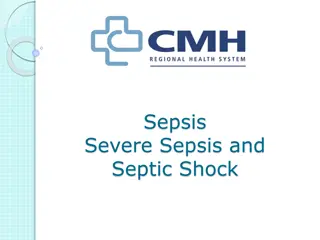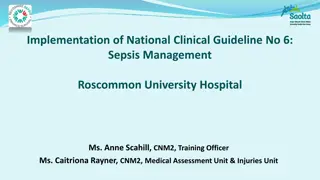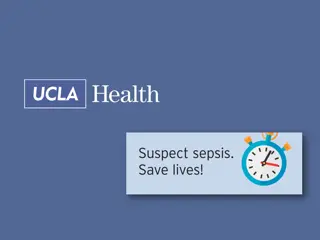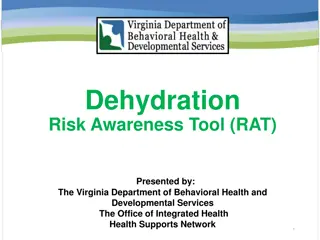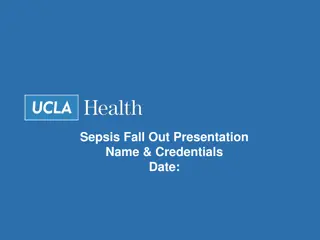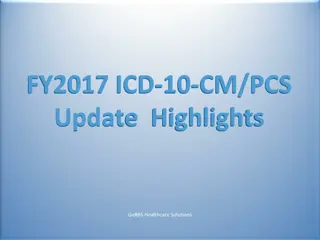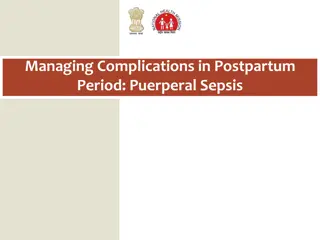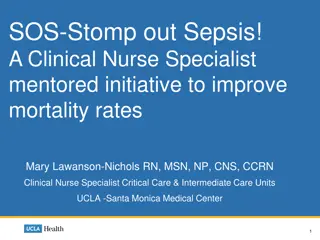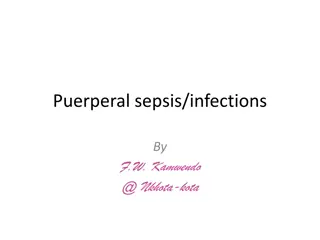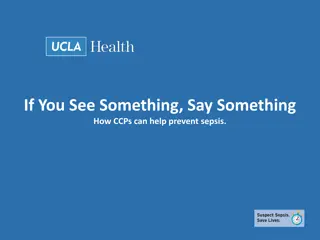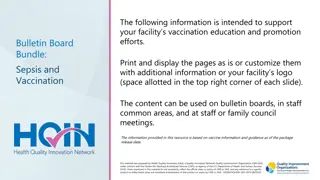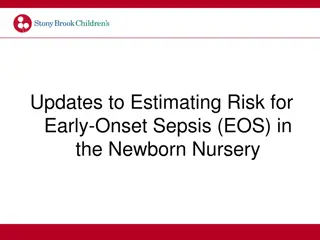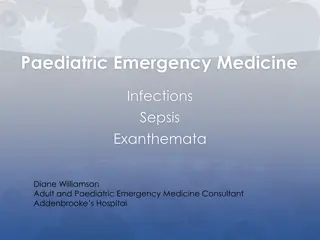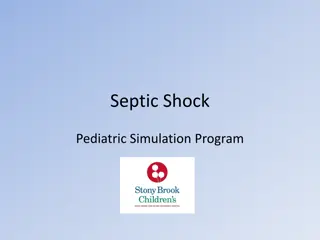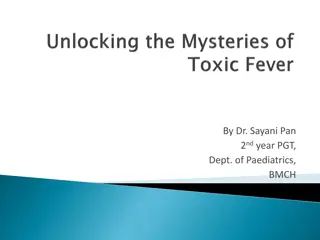Sepsis Risk Awareness Tool (RAT) Training Program Overview
The Sepsis Risk Awareness Tool (RAT) training program by The Virginia Department of Behavioral Health and Developmental Services aims to educate support coordinators, DSPs, and caregivers about the risk factors, signs, and symptoms of sepsis. It covers definitions, risk factors, signs, symptoms, diagnostic tests, complications, prevention measures, and the importance of reporting changes related to sepsis. The program emphasizes the severity of sepsis, its common causes, and the impact on individuals, highlighting the need for prompt recognition and intervention to prevent severe outcomes.
Download Presentation

Please find below an Image/Link to download the presentation.
The content on the website is provided AS IS for your information and personal use only. It may not be sold, licensed, or shared on other websites without obtaining consent from the author. Download presentation by click this link. If you encounter any issues during the download, it is possible that the publisher has removed the file from their server.
E N D
Presentation Transcript
Sepsis Risk Awareness Tool (RAT) Presented by: The Virginia Department of Behavioral Health and Developmental Services The Office of Integrated Health Health Supports Network 1
2 Who benefits from this training? Support Coordinators-you will learn important risk factors associated with sepsis, understand the signs and symptoms that DSP's and caregivers are going to recognize and provide in documentation, and learn diagnosis that may be associated with risk factors. DSP's and caregivers- you will learn important risk factors associated with sepsis, learn to recognize signs and symptoms, and how to report and document.
Objectives 1. State the definition of sepsis. 2. State (3) risk factors for sepsis. 3. Identify (4) signs and symptoms of sepsis. 4. Name a test used by physicians to diagnose sepsis. 5. State (2) complications from sepsis. 6. State why reporting change is important. 7. Identify (3) measures to prevent sepsis.
Terms and definitions Bacteremia-infection in the bloodstream Electrolytes-are minerals in the body that have an electric UTI- refers to a urinary tract infection. Dialysis- A process where a machine performs the normal function of the kidneys by filtering harmful wastes, salt, and excess water from the blood. Ventilator-A machine that supports breathing. Septicemia- infection enters the bloodstream, another term for sepsis Organ failure- when organs cannot perform their function and other parts of the body are affected. 4
What is sepsis? Sepsis occurs when there is untreated infection present in the body. The extreme reaction can be life threatening. Infections that are often at the root of the cause are UTI s, pressure injuries, respiratory infections (pneumonia). Medical conditions that complicate sepsis further are chronic kidney disease, cancer, diabetes, lung disease, cirrhosis, and HIV (Mayo Clinic, 2018). According to the CDC, 1.7 million adults in the U.S. each year develop sepsis. 270,000 people die each year from sepsis 1 out of 3 people who die in the hospital have sepsis 5 (CDC, 2020)
Signs and Signs and Symptoms Symptoms than 100mm Hg Fever Shivering Feeling cold Extreme Pain Discomfort Clammy, sweaty skin Decreased urine output Skin rash Confusion Short of breath Increased heart rate Blood Pressure Systolic less (CDC, 2019) (Mayo Clinic, 2018) and (Johns Hopkins, n.d.) 6
People 65years and older Chronic conditions such as diabetes, cancer, kidney disease, lung disease, bacteremia Weak immune system Diabetes Cirrhosis Already in the ICU/very sick (Intensive Care Unit) Children younger than 1yr old Wounds, injuries, or burns Organ transplants Invasive devices presents (catheters, breathing tubes) Has previously received antibiotics and/or corticosteroids (Mayo Clinic, 2018) Risk factors for Sepsis 7
Diagnosing Sepsis IMAGING: X-ray: to check lungs for pneumonia. CT Scan: infections in the pancreas and appendix are easier to visualize by CT. Ultrasound: gallbladder and ovaries are easily identified. MRI: identify infections in the soft tissues. (Mayo Clinic, 2018). BLOOD TEST: look for the following information: Infection-A high or low white blood cell count. A blood culture that is positive for infection. Abnormal kidney or liver function. Clotting issues. Low platelet count Blood oxygen levels. Electrolyte imbalances (Acidosis -too much acid in the blood). OTHER: Urinalysis- checks for bacteria in the urine. Wound drainage- a culture of drainage from open wounds to identify bacteria. Respiratory mucus- a culture of mucus coughed up to identify bacteria. 8
Antibiotics- will be started quickly. A broad-spectrum antibiotic will be administered until culture and sensitivity tests are complete to identify bacteria. Antibiotic may be changed or an additional medication added once tests are complete. IV fluids- increase blood volume and urine output, keep fluids circulating to vital organs Vasopressors-constricts blood vessels and increases blood pressure Corticosteroids-reduces inflammation and triggers tissue repair Treatment Treatment Insulin- helps to control blood sugar levels Pain relief- pain, discomfort, and fever Sedatives- if a ventilator is required (Johns Hopkins, n.d) (Mayo Clinic, 2018) 9
Complications of Sepsis Acute respiratory distress syndrome (ARDS). ARDS is a life- threatening condition that prevents ad equate oxygen from reaching the lungs and blood. ARDS can result in permanent lung damage and may result the person being placed on a ventilator to assist with breathing Septic shock-Toxins released by the bacteria in the bloodstream can cause extremely low blood flow, serious drop in blood pressure which may result in organ or tissue damage Kidney failure (May require dialysis) Tissue death (gangrene) of fingers or toes that may require amputation. Small blood clots can form throughout your body. The clots block the flow of blood and oxygen to vital organs and other parts of the body. The clots can increase the risk of organ failure and tissue death Permanent brain damage, which can cause memory problems or more severe symptoms Endocarditis- Damage to the heart valves which can lead to heart failure. Post-sepsis syndrome- consistent cognitive, psychological, physical, and medical defects following severe sepsis(Mostel, et al., 2019). Death- due to multiple organ failure. 10 (O'Connell & Cafasso,2018) (Hotchkiss, et al., 2016)
Taking steps to prevent the spread of infection can reduce the risk of developing sepsis. Receiving vaccinations annually. Receiving vaccinations for flu, pneumonia, and other infections. Encourage good hygiene. Proper wound care, handwashing, and bathing regularly. Sustain mobility to reduce weakness and prevent pressure injury. Maintaining sufficient nutritional status. Obtaining immediate care when signs of infection are recognized. The sooner treatment is received, the better the outcome. Prevention Prevention (O'Connell, 2018) 11
Importance of reporting change Sepsis is life threatening. The quicker symptoms are recognized the better! Individuals with intellectual and developmental disabilities are at a disadvantage due to limited communication skills and inability to report pain. Using behavior changes as an indicator for pain when individuals are unable to report is an acceptable approach (Herr et al., 2006). Respiratory infections and UTI's are common among individuals with intellectual and developmental disabilities. These individuals are at higher risk for septicemia and would benefit from preventive measures and early recognition (Ailey, Johnson, Fogg, & Friese, (2014). Any changes or recognition that an individual has signs and symptoms on sepsis should be reported immediately. The individual should be taken to their PCP, Urgent Care, or ER if issue is found on a weekend. Document your findings in daily note and who it was reported to. 12
DSP's connect the dots.... Situation: Edward has been seen at Urgent Care twice this year for UTI s. He requires prompting to drink and wash his hands. He uses hand mouthing as a coping mechanism. Yesterday Edward participated well. Today Edward is not drinking even with encouragement. He seems warm to touch, is frowning, and his urine was dark and had an odor at the last brief change. Example of a daily note: Edward was showing signs of a possible UTI today. He refused to drink and felt warm to touch, Temp 99.6. His urine was very dark and has an odor. DSP notified the Manager and was instructed to take him to Urgent Care. Urgent Care instructed that he be taken to the ER. He was admitted with Sepsis. Example only: follow your agency documentation standards. Way to go DSP, you recognized a change! 13
DSP's connect the dots.... You are the boots on the ground! Based on your daily observations you may recognize a change in status that would require evaluation. If you notice any of the risk factors listed below for sepsis, report and document it quickly. Use the RAT tool to help staff be aware of risks and prompts changes within plans and support instructions. The RAT can help providers be proactive. 14
Case Study Larry resides in a group home. Larry is the first to awake in the home every morning anxious to receive his morning coffee. Larry refers to everyone as friend and loves to set on the patio to greet everyone coming and going. Larry has CHF (congestive heart failure) and COPD (chronic obstructive pulmonary disease). Larry just finished an antibiotic a week ago for a lung infection. Larry awoke one morning and voiced "I just don't feel good". Larry was having a hard time ambulating due to his feet and ankles swelling. Larry resided in his recliner most of the day with his feet up,but did not rest well due to a persistant cough. Larry did not finish his morning cup of coffee and refused his lunch. Larry complains he is cold. Larry request to go to his room and lie down. When staff assist him to his room, they notice Larry's skin is sweaty and he is breathing harder than normal. 15
Apply what you ve learned What are three (3) interventions that could be utilized to help Larry. 1. ____________________________ 2. ____________________________ 3. ____________________________ 16
Connect the dots with the RAT Tool... SC's- as you are completing the RAT tool keep in mind there are key diagnoses and situations you need to incorporate in discussion with providers and caregivers to ensure risk factors are being recognized. Individual has asthma, COPD, emphysema Individual is non- verbal, cannot express pain Individual is prone to have urinary tract infections Individual is incontinent and has frequent skin breakdown Individual's that are immunocompromised or have received long-term antibiotic therapy and have developed an tibiotic resistance. RAT TOOL Individual's that have a previous medical DX of sepsis. Sepsis can be the result of bacterial, fungal, or viral infections Look for infections caused by Staph, E.Coli, Streptococcus 17
Follow these steps to success Prior to ISP meeting, review discharge summaries, medical reports, and health history for information. Remember! Think about all settings: home, Day Support, Community Engagement Skip Step 2 and go to Section G 18
Follow these steps to success During the ISP meeting ask all participants if they are aware of any risk factors listed in Step 2 19 Dr. Hopewell Nov 15, 20
References Ailey, S., Johnson, T., Fogg, L., & Friese, T. (2014). Hospitalizations of adults with intellectual and developmental disability in academic medical centers. Intellectual and developmental disability, 52(3),187-192. Doi: 10.1352/1934-9556-52.3.187 Center for Disease Control and Prevention (CDC). (2019). What is sepsis? Retrieved from https://www.cdc.gov/sepsis/what-is-sepsis.html Center for Disease Control and Prevention (CDC). (2016). Making healthcare safer. Think Sepsis. Time Matters. Retrieved from https://www.cdc.gov/vitalsigns/pdf/2016-08-vitalsigns.pdf Center for Disease Control and Prevention (CDC). (2020). Data & Reporting: Sepsis. Retrieved from https://www.cdc.gov/sepsis/datareports/index.html Clevland Clinic.(n.d.). Sepsis Diagnosis and Tests. Retrieved from https://my.clevelandclinic.org/health/diseases/12361- sepsis/diagnosis-and-tests Herr, K., Coyne, P., Key, T., Manworren, R., McCaffery, M., Merkel, S., Kelly, J., & Wild, L. (2006). Pain assessment in the non-verbal patient: Position statement with clinical practice recommendations. Pain Management Nursing, 7(2), 44- 52. Hotchkiss, R., Moldawer, L., Opal, S., Reinhart, K., Turnbull, I., & Vincent, J. L. (2016). Sepsis and septic shock. Nature reviews. Disease primers, 2, 16045. https://doi.org/10.1038/nrdp.2016.45 Johns Hopkins. (n.d). Sepsis. Retrieved from https://www.hopkinsmedicine.org/health/conditions-and-diseases/sepsis Mayo Clinic (2018). Sepsis: Risk Factors. Retrieved from https://www.mayoclinic.org/diseases-conditions/sepsis/symptoms- causes/syc-20351214 Mayo Clinic. (2018). Sepsis: Overview. Retrieved from https://www.mayoclinic.org/diseases- conditions/sepsis/symptoms-causes/syc-20351214 Mostel, Z., Perl, A., Marck, M., Mehdi, S. F., Lowell, B., Bathija, S., Roth, J. (2019). Post-sepsis syndrome an evolving entity that afflicts survivors of sepsis. Molecular Medicine, 26(1). doi: 10.1186/s10020-019-0132-z O'Connell ,K., (2018). Sepsis. Retrieved from https://www.healthline.com/health/sepsis O'Connell , K., & Cafasso, J. (2018). Septicemia. Retrieved from https://www.healthline.com/health/septicemia 21
Resources Resources Printable Posters from the CDC: https://www.cdc.gov/sepsis/education/patient-resources.html Sepsis Alliance Fact Sheet: file:///C:/Users/dbk75942/Downloads/Sepsis-FactSheet-v2- 4.pdf Sepsis Alliance https://www.sepsis.org/ 22


